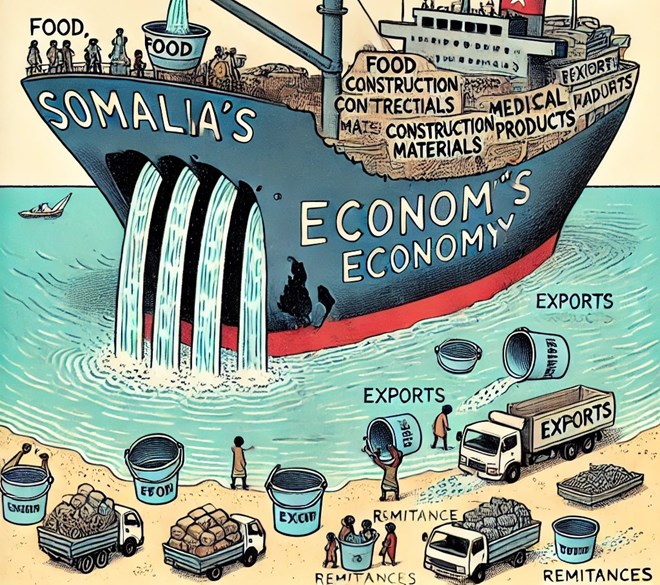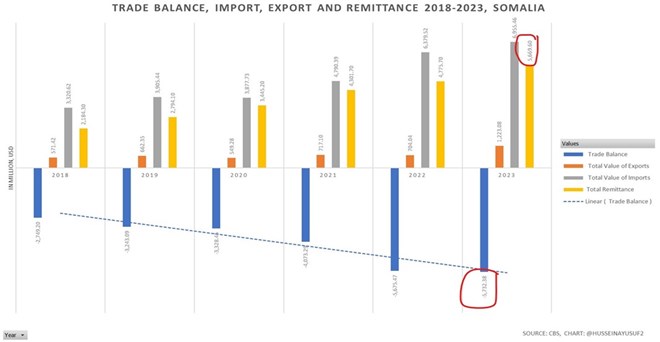Saturday August 24, 2024
By Hussein Abdullahi Yusuf

Somalis trade deficit has
significantly widened over the past six years. In 2018, Somalia faced a trade
deficit of USD 2.749 billion, which expanded to USD 5.7 billion by 2023. The
total import value increased from USD 3.3 billion in 2018 to USD 6.955 billion
in 2023, while the total export value grew from USD 571 million to USD 1.223
billion.
This trade imbalance has led to a
substantial outflow of foreign currency that has adversely impacted local
production capabilities as cheap imported goods flog the market, rendering
domestic production in an uncompetitive position.
Remittances constitute Somalia's
primary source of foreign exchange. These inflows are primarily used to fund
the country’s import bill, resulting in an outflow of U.S. dollars from
domestic circulation to pay foreign exporters to Somalia. In 2023, remittance
inflows totaled USD 5.6 billion, whereas the trade deficit was USD 5.7 billion.
This data indicates that the entirety of the remittance inflows was directed
towards settling the import bill, hence, the fund left the country with one
2023, without creating much long term value as depicted in the graph below.
Purpose of the article is to
explore the reasons behind the widening trade imbalance and suggest potential
solutions.
Trade deficit is defined as when
a country`s imports more goods and services than it exports, resulting in a
negative balance of trade. The total import value in 2018 was USD 3.3 Billion
while the total export value was USD 571 Million, leaving the country's trade
deficit of USD 2.749 Billion. Fast forward in 2023, the total import value was
USD 6.955 Billion while total export value was at USD 1.223 Billion, leaving
the country trade deficit of USD 5.732 Billion, as the below graph depicts.

The challenges constraining
Somalia's export capacity include limited funding, inadequate international
market access for value-added products, and insufficient infrastructure for
processing and storing goods. The country has experienced a trade deficit due
to a range of interconnected factors, which are rooted in both structural and
situational issues. Key causes include
Political Instability: Somalia has experienced prolonged periods of
conflict and instability, which have disrupted economic activities, including
trade and investment. The lack of a stable government and infrastructure has
made it difficult to manage and develop trade effectively.
Weak Infrastructure: Poor infrastructure, including inadequate road
network, and communication systems, hinders trade by increasing transaction
costs and reducing the efficiency of moving goods both within the country and
across borders.
Limited Industrial Base: Somalia’s industrial sector is relatively
under/not developed, leading to a heavy reliance on imports for manufactured
goods and capital equipment. This lack of domestic production capacity
contributes significantly to the trade deficit.
Dependence on Imports: The country relies heavily on imports for
essential goods, including food, fuel, and machinery. This high dependency
exacerbates the trade imbalance, as the value of imports often far exceeds that
of exports.
The primary causes of the trade
deficit are Somalia’s inability to produce goods and services, mainly food and
construction materials as those two categories dominate in our import bill.
Somalia imported USD 6.955
billion in 2023, compared to USD 6.080 billion in 2022. The main import
categories in 2023 were as follows:
|
Somalia import Categories
|
|
Category
|
2023 (Million USD)
|
% of the total imports
|
|
Food
|
2,002.52
|
28.8%
|
|
Construction
|
1,340.24
|
19.3%
|
|
Medical Products
|
797.89
|
11.5%
|
|
Cars & Spare parts
|
467.42
|
6.7%
|
|
Oil & Gas
|
560.00
|
8.1%
|
|
Others Including Khat
|
517.13
|
7.4%
|
|
Clothes & Footwear
|
460.26
|
6.6%
|
|
Personal Care
|
202.49
|
2.9%
|
|
Furniture and Utensils
|
143.70
|
2.1%
|
|
Electronics & E. Machines
|
158.71
|
2.3%
|
|
Beverages & Tobacco
|
105.55
|
1.5%
|
|
Cosmetics
|
106.29
|
1.5%
|
|
Plant Industry
|
62.23
|
0.9%
|
|
Stationary
|
31.04
|
0.4%
|
|
Total
|
6,955.46
|
|
This indicates that food,
construction, and medical products accounted for two-thirds of a percentage
point of the import bill. Specifically, food accounted for 28.8% in 2023.
Low Export Capacity: Somalia's export sector is constrained by
various factors, including the limited diversity of products mainly
concentrating on livestock-related products, low production levels, and
challenges in meeting international standards. Additionally, issues such as
insecurity and lack of access to global markets further limit export
opportunities.
Further, our limited export
capacity also exacerbates the gap, in 2023 the total export value was USD 1.223
Billion, and most of this export was livestock-related categories with little
value added.
|
Somalia Export Categories, In Millions, USD
|
|
Category
|
2022 (Million USD)
|
2023 (Million USD)
|
|
Livestock
|
558.38
|
1,069.4
|
|
Crops & Veg Oil
|
45.61
|
63.49
|
|
Meat
|
16.1
|
15.95
|
|
Forest Products
|
12.87
|
11.34
|
|
Others
|
13.06
|
35.61
|
|
Hides & Skins
|
7.04
|
7.33
|
|
Fishery
|
51.33
|
15
|
Security Concerns:
Persistent security issues, including terrorist attacks and internal conflicts,
deterred investment in the most fertile and productive areas of the country
including Juba Valley that are rich in agricultural. Moreover, concerns of
piracy attacks are hindering in fishery investments, which could have produced
fish that we can export to neighboring country including Ethiopia, where there
is a huge demand for seafood products for religious and health purposes. Therefore,
Security Concerns, further exacerbate Somalia’s trade balance.
Economic Mismanagement:
Issues such as corruption, nepotism, lack of effective economic policies,
talent mismanagement, not allocating the right man for the right job and poor
financial management exacerbate trade imbalances by creating inefficiencies in
public and private sectors and hindering economic growth.
International Trade Barriers:
Somalia faces barriers to trade such as tariffs, trade restrictions, sanctions,
and additional due diligence measures as the country`s weak quality assurance
protocols, affect its ability to engage effectively in global markets. In some
instances, Somali products are forced to be exported to another country to get
the label and license and then re-export to the destination.
Addressing
Somalia's trade deficit requires a comprehensive approach that involves
enhancing both the supply side and demand side of the economy. Here are several
strategies, along with examples from Sub-Saharan Africa (SSA) that have
implemented similar measures:
1. Improve Infrastructure
Strategy: Invest in infrastructure such as ports, and
roads, to facilitate trade and reduce transaction costs.
Examples:
Rwanda: The government has invested in
improving roads and logistics through the "Rwanda Transport
Infrastructure Project," which has streamlined the movement of goods
and bolstered trade.
2. Enhance Industrialization
Strategy: Develop local industries to reduce dependence
on imports and increase export capacity by focusing on value addition and
diversification.
Examples:
Kenya: The "Big Four Agenda"
includes industrialization as a key pillar. Kenya has invested in special
economic zones and industrial parks, leading to increased manufacturing
output and export diversification.
In Ethiopia, one industrial park alone -Hawassa
Industrial Park- employs more than 20,000 people.
3. Strengthen Governance and Reduce Corruption
Strategy: Implement better governance practices and
anti-corruption measures to create a more favorable business environment and
attract foreign investment.
Examples:
Botswana: Known for its strong governance
and low corruption levels, Botswana has created a stable business
environment that supports economic growth and trade.
4. Promote Export-Oriented Policies
Strategy: Develop policies that incentivize and support
the export sector, including export subsidies, tax incentives, and access to
international markets.
Examples:
South
Africa: The
government provides various incentives for exporters, including tax
rebates and support programs, which have helped South Africa maintain a
competitive edge in international markets.
5. Develop Human Capital and Skills
Strategy: Invest in education and vocational training
to develop a skilled workforce capable of supporting and growing the trade
sector.
Examples:
Ghana: The government’s focus on
education and skills development through initiatives like the
"Technical and Vocational Education and Training (TVET)"
programs has helped improve the labor force’s skills that support sectors
such as business process outsourcing, and ultimately supporting industrial
and export growth.
6. Enhance Trade Facilitation and Access to
Global Markets
Strategy: Improve trade facilitation measures such as
customs procedures and trade agreements to better integrate into the global
economy.
Examples:
Somalia
joining the East Africa Communities is very successful endeavor. Additionally,
we should also focus on joining other trade communities in Middle East to
further our business relations.
7. Foster Public-Private Partnerships
Strategy: Encourage collaboration between the
government and private sector to drive investment and innovation in
trade-related activities.
Examples:
Nigeria: The Nigerian government has
partnered with private investors to develop infrastructure and industrial
projects, aiming to enhance trade and economic growth.
Somalia: The
recent regulation approved by council of ministries pertaining to
Public-Private Partnerships is welcoming start; however, the government
should materialize this relation by allowing the private sector to engage
more in business.
8. Enhance
Access to Finance
Strategy:
Improve access to finance for businesses to support investment in key sectors,
industrial development, and trade activities.
Examples:
Nigeria: The
Central Bank of Nigeria’s intervention programs, such as the Anchor
Borrowers' Program, provide funding to small and medium-sized enterprises
(SMEs), supporting their growth and export capacity.
9. Invest in Energy Infrastructure and Develop
Regional Energy Integration
Strategy:
Integrate with regional and neighboring energy markets to access a broader
energy supply, reduce energy prices and create economies of scale.
Examples:
West Africa: The
West African Power Pool (WAPP) facilitates cross-border electricity trade,
improving energy security and supporting regional economic growth.
Somalia: The
current energy price of USD 0.42 per Kilowatt in Somalia is unaffordable
and cannot support for industrial growth. Energy importation from
neighboring countries is viable alternative to combat higher energy costs.
Renewable energy is another alternative in which funds can be secured from
the Gulf countries or international financial institutions.
Implementing
these strategies in Somalia would involve tailored approaches considering the
country's specific context and challenges. By learning from the experiences of
other SSA and DCs, Somalia can develop a multi-faceted strategy to address its
trade deficit effectively.
Hussein Abdullahi Yusuf is a consultant,
economist and financial sector analyst in Eastern Africa and MENA.
Contacts
Email:
[email protected]
Tell:
+252611698907
Facebook: https://www.facebook.com/profile.php?id=100069787405612&mibextid=ZbWKwL
X: https://x.com/HusseinAYusuf2?t=y-Snvyo2rdz0_KVyuSyWjw&s=35
References
(Central Bank of Somalia, 2024) Quarterly-Economic-Report_Q4_2023_09-06-24.pdf